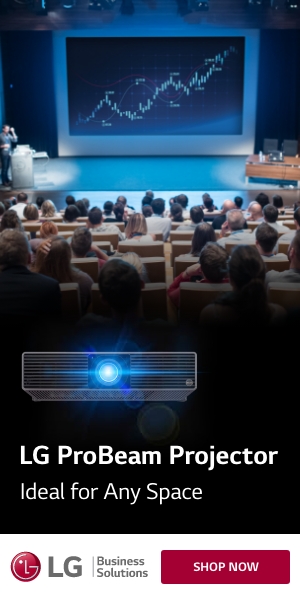Motion-picture projectors have come a long way since their hand-cranked progenitors over a century ago. For the first half of their history, they relied exclusively on film to provide moving images that were projected onto a screen, and that technology continued to be used in commercial cinemas until around 2000.
Meanwhile, cathode-ray tube-based video projectors were developed in the 1950s using red, green, and blue CRTs to project electronic video images onto a screen. Many home-theater buffs remember those huge, heavy boxes with the bulging red, green, and blue eyes.
Today, film has been almost completely replaced by digital-video projectors that are based on one of three imaging technologies: LCD, LCoS, and DLP. All of these technologies offer many advantages over film and CRT projectors—smaller size, lower weight, less heat generation, and more efficient energy usage—and each one has its own strengths and weaknesses for different applications.
In this article, I'll explain how each technology works and reveal its maximum capabilities. Then, I'll offer a comparative analysis of their advantages and limitations, with the key points summarized at the end in an easy-to-reference list. So, buckle up for a deep dive into the world of digital projection.
LCD
The first digital-projection technology was LCD (liquid crystal display). It was conceived by Gene Dolgoff in 1968, but LCD technology was not sufficiently developed to be practical in a projector at the time; that would have to wait until the mid-1980s.
The basic idea is relatively simple. White light from a lamp is split into red, green, and blue components using dichroic mirrors, which reflect certain wavelengths and pass other wavelengths. These three mirrors convert the white light into the red, green, and blue primary colors from which all colors can be derived (Fig. 1). You can read ProjectorCentral's article "Lamp, Laser, or LED Projection: Which Light is Right?" for more on this concept of "additive color" and a deeper discussion of the differences among light sources.
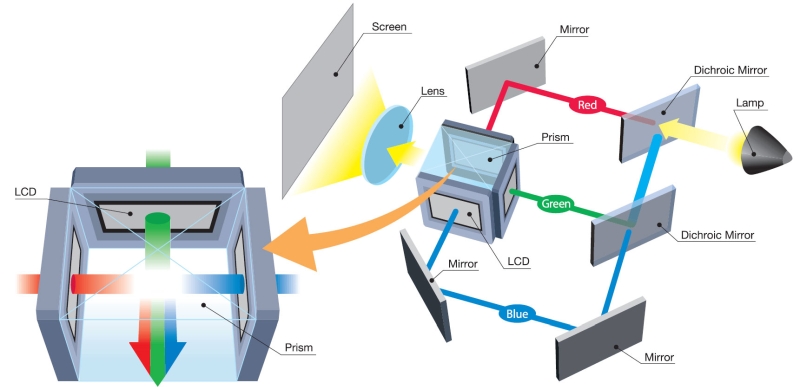
In some LCD projectors, the light source is a blue laser. With most laser projectors, some of the blue light from the laser hits a spinning wheel coated with phosphor that emits yellow light, which is then split into its red and green components using dichroic mirrors (Fig. 2). The rest of the blue laser light is directed to the blue imager.
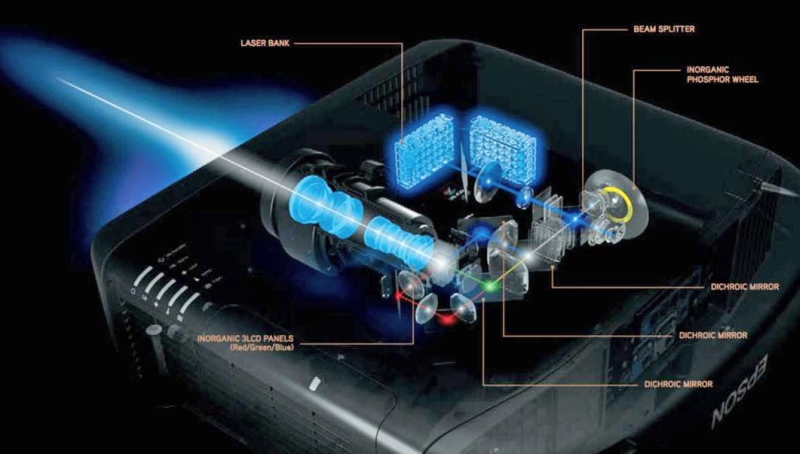
Either way, each beam of red, green, and blue light is directed toward its own LCD imager, which typically measures 0.55-inch to about 1-inch diagonally (Fig. 3) and consists of an array of tiny, transparent cells. These cells are individually and dynamically controlled by electrical signals to allow more or less light to pass through them at any given moment. Each cell can be made transparent, opaque, or translucent in varying degrees based on the signal. As the cells change the amount of light they pass, they form a digital image for each frame in the video signal.
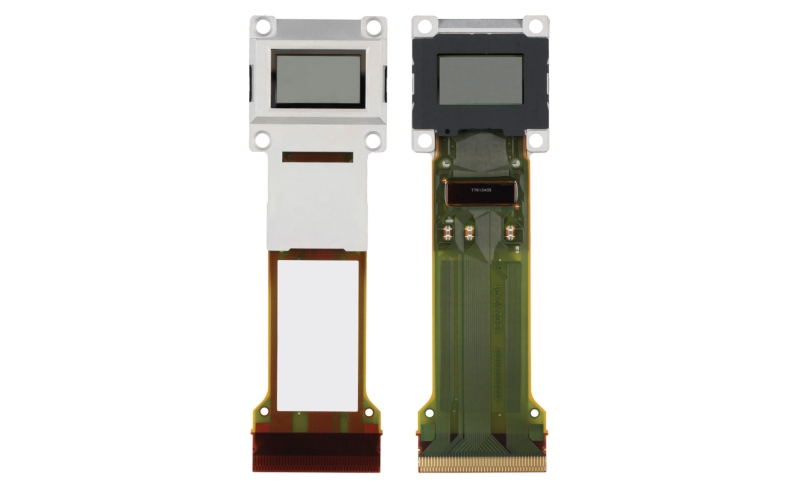
The imager for each color forms a portion of the final image associated with that color, and the image is generally held for each entire frame in the video signal; this process is called sample and hold. Modern LCD imagers can be switched at faster rates—up to 480 times per second—which allows projector designers to implement features such as 3D, frame interpolation, and pixel-shifted UHD (more on that in a moment) instead of holding one image for the entire frame.
After the red, green, and blue light beams pass through the corresponding imagers, they are combined using a dichroic prism and projected onto a screen through the main lens, forming a full-color image (Fig. 1).
The individual cells in an LCD imager measure about 6 to 12 microns across and are surrounded by opaque lines that carry the electrical signals to control each cell's transparency. These lines occupy a certain percentage of the total area of the imager that can't be used as part of the image. The percentage of the total area that can be used as part of the image—in other words, the area occupied by the cells themselves—is called the fill factor, which is roughly 80% to 90% for LCD imagers. As a result, it's possible to see the boundaries around the pixels as you get close to the screen, which is known as the screen-door effect. Some longtime enthusiasts may recall the prominence of screen-door effect in earlier, lower-resolution LCD projectors, though today's 1080p imagers have greatly reduced its visibility on a typical-size home-theater screen.
How do you choose the right screen for your projector?
Our Projector Screen Buyer's Guide will take you through the process of finding the correct screen for your projector and space.
Screen Buyer's Guide
Another important characteristic of all digital projection imagers is their inherent or native contrast ratio—that is, the ratio of the most to least light they can pass without enhancements such as a dynamic iris or modulated light source. Epson won't reveal the native contrast ratio of its LCD imagers, but the company's UB (Ultra Black) enhancement technology—which incorporates a dynamic iris and light polarization to reduce light scatter in the engine—is known to achieve impressive contrast ratios and black levels when viewed in appropriately dark conditions.
Most modern LCD imagers have resolutions up to 1920x1200 (WUXGA); home-theater models typically use 1920x1080 (1080p) imagers. Higher resolutions are possible but uncommon—I know of only one commercially available projector today that uses LCD imagers with native 3840x2160 (UHD) resolution: the recently introduced Epson Pro L12000QNL, which is designed for large venues such as stadiums and convention halls.
Some home-theater LCD projectors with 1080p imagers simulate UHD resolution with a pixel-shifting technique. The pixel-shifting in Epson's models is part of a technology suite Epson calls 4K PRO-UHD. In this process, an optical refracting plate oscillates back and forth, shifting the final image diagonally by half a pixel once per frame (Fig. 4). Because the LCD cells can be switched to different levels of transparency much faster than any current frame rate, each set of shifted pixels is independently controllable, doubling the effective number of pixels on the screen. In addition, the pixels overlap, so the pixel grid is more dense, further reducing the screen-door effect.

Such projectors can accept and display a UHD video signal, but the actual number of pixels on the screen is only half of the 8.3 million pixels in the signal. Even so, by many reliable accounts, the image is much sharper and more detailed than a 1080p image. Can the best pixel-shifted 1080p subjectively deliver the same on-screen detail as a projector that renders the full UHD pixel count on the screen? This remains a subject of debate among manufacturers and enthusiasts. Along with the native resolution of the imagers, the level of detail perceived on-screen relies on the execution of the pixel-shifting technology and the associated optics, among other factors.
LCD imagers for projectors are made by Epson and Sony. Epson is the only major manufacturer of consumer-oriented LCD projectors, though it also makes models for business and educational applications as well as large venues. Sony makes a variety of LCD projectors for the business and education markets, and Panasonic offers models for large-venue and commercial installations. Other companies that make LCD projectors for various applications include Christie, Maxell, NEC, Ricoh, and Sharp.
LCoS
LCoS (liquid crystal on silicon) is a variation of LCD technology. General Electric first demonstrated a low-resolution LCoS projector in the 1970s, but it wasn't until 1998 that JVC introduced its first SXGA+ (1400x1050) projector using its implementation of LCoS technology, which the company calls D-ILA (Direct Drive Image Light Amplifier). In 2005, Sony introduced its first 1080p home-theater model, the VPL-VW100 (aka "Ruby"), using its own implementation of LCoS—called SXRD (Silicon X-tal Reflective Display)—which was followed by JVC's DLA-RS1 in 2007.
Like LCD projectors, LCoS projectors separate light into its red, green, and blue components that are directed to three separate LCD-based imagers. But instead of light simply passing through the LCD cells, it is reflected off a shiny surface directly behind the cell array and passes back through the cells again (Fig. 5).
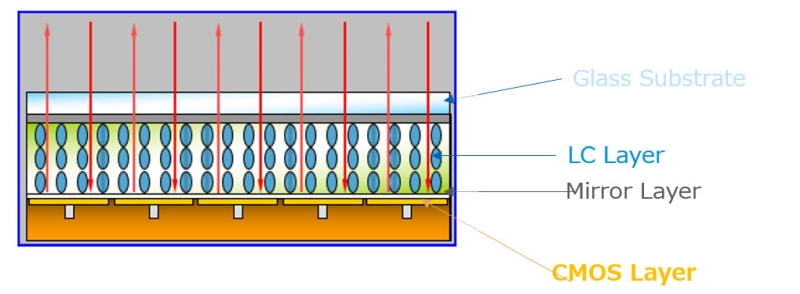
The light source in LCoS projectors is often a white lamp, but some use a blue laser and yellow phosphor wheel as the light source, a technology that JVC calls Blu-Escent and Sony calls Z-Phosphor. Either way, as with LCD projectors, the red, green, and blue light beams are directed to their respective imagers. The reflected light from the three imagers is then combined and projected onto a screen through the main lens (Fig. 6).
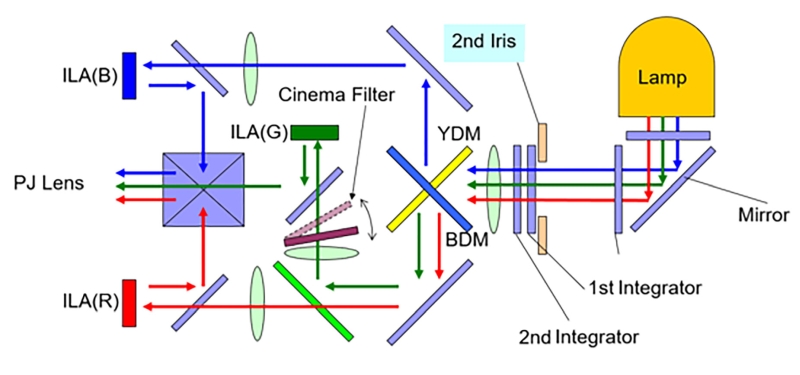
LCoS imagers today measure 0.7 to 1.3 inches diagonally (Fig. 7). As with LCD, each imager forms its image and generally holds it for each frame. Modern LCoS imagers can switch at rates up to 120 Hz, which allows things like 3D, frame interpolation, and pixel-shifted UHD. At 120 Hz, however, they can't do pixel-shifted UHD and 3D at the same time.
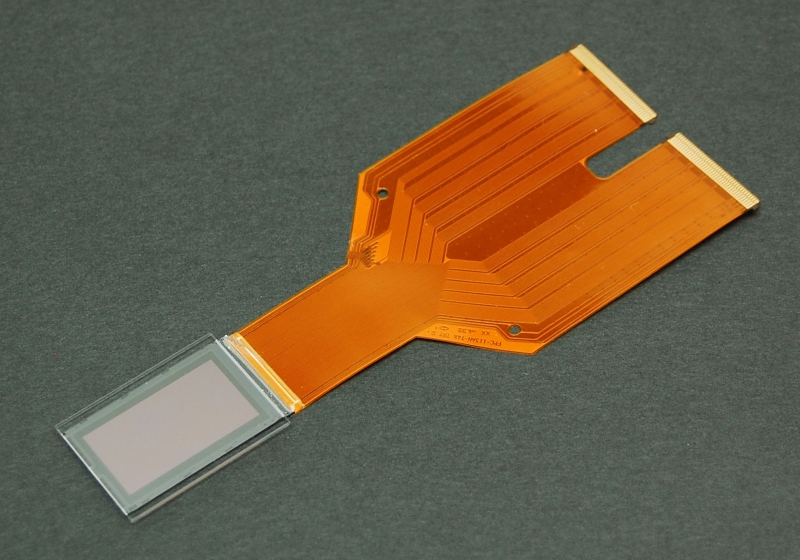
JVC's D-ILA cells currently measure from 3.8 to 8 microns in size, and the fill factor is over 93%. In addition, the company has developed a technique that purports to control the liquid-crystal molecules floating in the gaps between cells to virtually eliminate any screen-door effect (see Fig. 8).
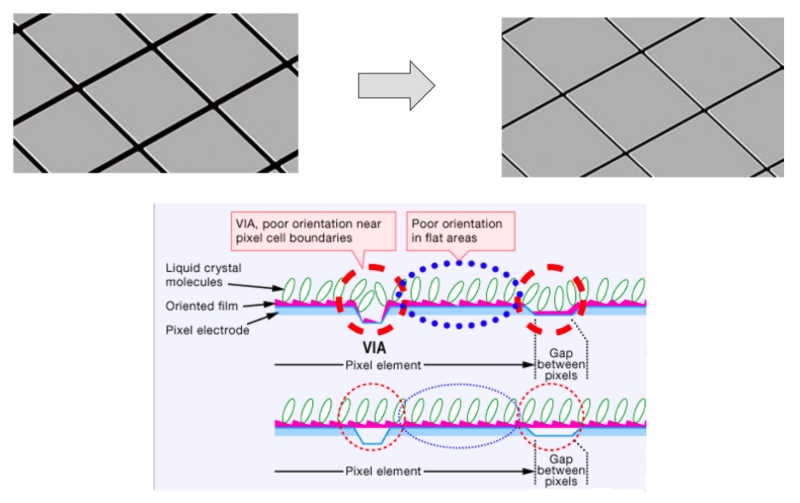
LCoS is generally considered to have the best native contrast and black levels of all the digital-projection technologies. Of course, a dynamic iris and/or dynamic illumination modulation can improve blacks and contrast even further.
Commonly available LCoS imagers have reached a native resolution of 4K (4096x2160), and they are used in the JVC DLA-NX series and RS4500 as well as the Sony VPL-VW series and VPL-VZ1000ES ultra-short-throw projector. Sony also offers native 1080p resolution in the less-expensive VPL-HW series. In addition, JVC has created a native-8K (7680x4320) imager that's used for simulators and prototype large-venue demonstrations.
In some models, JVC uses a pixel-shifting technique it calls e-Shift to double the number of pixels projected onto the screen from native 1080p imagers. Much like Epson's 4K PRO-UHD, e-Shift uses an oscillating optical refracting plate placed after the red, green, and blue images have been combined into a full-color image. The device shifts the pixels back and forth diagonally by half a pixel 120 times per second (Fig. 9), and each set of pixels is independently controllable in terms of color and brightness.
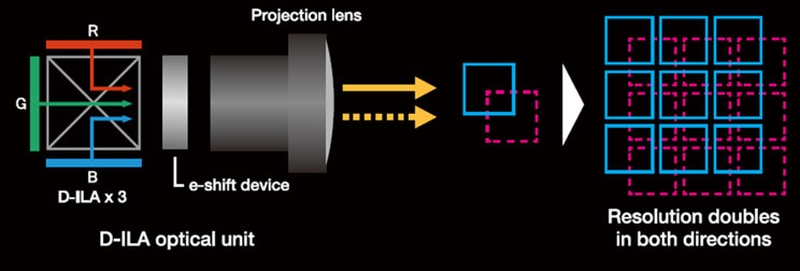
This doubles the number of pixels on the screen, though JVC claims it virtually quadruples the number of pixels, doubling them both vertically and horizontally. So, native 1920x1080 supposedly becomes 3840x2160. But in fact, there are only twice the number of independently controllable pixels on the screen, so 1920x1080 actually becomes 1920x1080x2. Like Epson projectors with 4K PRO-UHD, JVC projectors with 4K e-Shift can accept and display UHD video. In addition, signals with lower resolution, such as 1080p, are upscaled to 4K/UHD within the projector and split into two separate frames that are displayed alternately at 120 Hz.
Models with 4K e-Shift include anything in the DLA-X series, which have native-1080p imagers. However, except for one remaining model that was slowly being phased out in mid-2020—the DLA-X790 (also sold as the DLA-RS540)—all new JVC LCoS consumer projectors use imagers with native 4K resolution. Additionally, the flagship DLA-NX9 applies e-Shift to its native-4K imagers to achieve a claimed virtual resolution of 7680x4320 (actually 3840x2160x2), and it upscales lower resolution signals to 8K UHD before applying 8K e-Shift.
JVC and Sony make LCoS imagers for their own projectors, which include home-theater models as well as larger units for professional simulators and digital cinema. Canon uses JVC imagers in its business projectors, and Wolf Cinema bases some of its home-theater models on JVC imagers as well.
DLP
The newest kid on the digital-projection block is DLP (Digital Light Processing). Originally developed in 1987 by Larry Hornbeck at Texas Instruments, the first DLP-based projector was introduced by Digital Projection in 1997. Since then, DLP has come to dominate digital cinemas with a market share of about 85%. It's also very popular for home theaters as well as business, education, commercial entertainment, and other applications.
Like all digital projectors, DLP models direct red, green, and blue light to the imagers. White light from a lamp can be separated into its red, green, and blue components, or a blue laser can excite a phosphor wheel to emit yellow light, which is then split into its red and green components while some of the blue light from the laser is used to create the blue portion of the image directly. Other approaches call for adding a second dedicated red laser to the blue, or to use separate red, green, and blue lasers, but this last approach is very expensive and not used except in digital-cinema projectors, super-high-end home theaters, and other color-critical professional applications. Red, green, and blue LEDs have also been used in a few models, but they are not as bright as lasers, so they aren't used much these days.
In any case, red, green, and blue light is directed to DLP imagers, which currently measure from 0.2 inches for small, portable devices to 1.38 inches for digital-cinema projectors; home-theater models today typically use imagers that measure 0.47-inch or 0.66-inch diagonally. However, they work quite differently from LCD or LCoS imagers. Instead of tiny LCD cells, a DLP imager is covered with an array of microscopic mirrors that correspond to the individual pixels (Fig. 10). This type of imager is called a Digital Micromirror Device (DMD).

Each micromirror is mounted on a pivoting stalk that allows the mirror's orientation to alternate between two positions. In one position, light striking the mirror is reflected toward the projector's main lens and onto the screen; in the other position, the light is reflected away from the main lens into a light-absorbing area. (Fig. 11).
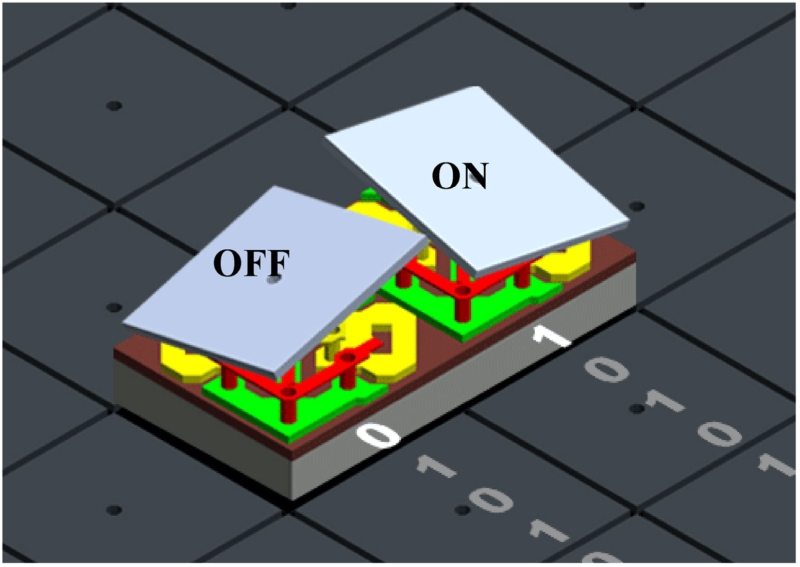
Each micromirror cycles between its "on" and "off" positions thousands of times during each frame of video, and the brightness of that pixel depends on how much of each cycle the mirror spends in its "on" position versus its "off" position. For example, if a micromirror spends 50% of each cycle in its "on" position and 50% in its "off" position, that pixel's brightness is 50% of its maximum. If the micromirror spends 10% of each cycle in its "on" position and 90% in its "off" position, that pixel's brightness is 10% of its maximum. The relationship between the amount of time the micromirror spends in its "on" and "off" positions during each cycle is called the duty cycle.
If this is confusing, consider a light switch in a room—flip the switch on, and the light turns on; flip the switch off, and the light turns off. Now, imagine that you can flip the switch between on and off many times per second. If the switch is on half the time and off half the time during each cycle, the light would appear to be dimmed to 50% of its normal brightness. If the switch is on 10% of the time and off 90% of the time during each cycle, the light would appear to be dimmed to 10% of its normal brightness.
A rapidly alternating light switch with a variable duty cycle acts as a dimmer because your eyes don't react fast enough to see the flickering; all you see is different brightness levels that depend on the duty cycle of the flipping light switch. The same thing happens with the micromirrors on a DMD—each one flips between "on" and "off" so quickly, you perceive the corresponding pixel as brighter or dimmer depending on its duty cycle.
Each micromirror on modern DMDs measures 5.4 to 10.8 microns square, depending on the size and resolution of the imager, and the fill factor is over 90%. The native contrast of DMDs is generally less than LCoS imagers, though Texas Instruments made claims to contrast improvement through the years in successive generations of its "DarkChip" technology. More recently, however, TI and its supporting DLP projector manufacturing partners have not touted DarkChip much at all in promotion of DLP. As with other technologies, a dynamic iris and/or dynamic illumination modulation can greatly increase the effective contrast of the image on the screen.
The native resolution of DMDs used in modern digital-cinema and other super-high-end projectors is full digital-cinema spec 4K (4096x2160), while models for home theater and other applications often use DMDs with a native resolution of 1920x1080 or 2716x1528. And like with Epson 4K PRO-UHD and JVC e-Shift, those pixels can be shifted back and forth diagonally between two positions using an oscillating optical refraction plate to double the number of effective pixels on the screen. Texas Instruments calls this technology XPR (eXpanded Pixel Resolution). Unlike the Epson and JVC systems, however, XPR can actually shift the pixels to four different positions during each frame, allowing a native 1080p DMD to present true UHD (3840x2160) resolution on the screen from a native 1080p DMD (Fig. 12).
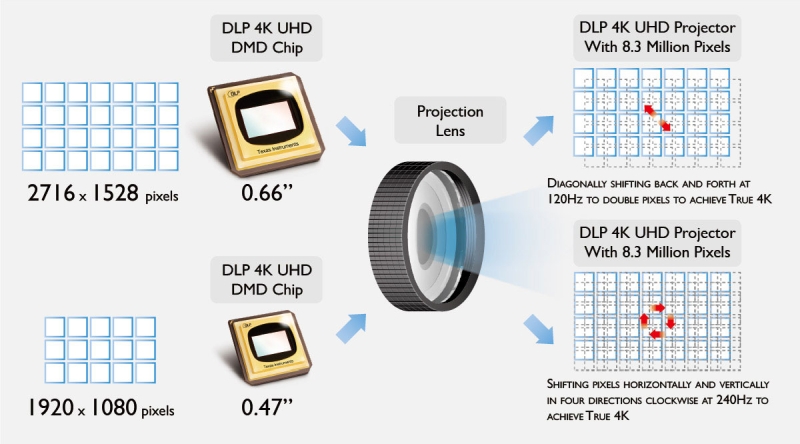
In addition, thanks to their super-fast switching speed, some DMDs can diagonally shift each micromirror between two different positions individually (Fig. 13); Texas Instruments calls this TRP (Tilt and Roll Pixel). For example, TRP is implemented on some 0.66-inch DMDs with a native resolution of 2716x1528, which is a total of 4.15 million micromirrors. By shifting those micromirrors back and forth between two positions, the number of pixels on the screen is doubled to 8.3 million, exactly the number of pixels in a true UHD (3840x2160) image. And in each of those two positions, the micromirrors continue to cycle between their "on" and "off" states many times per second, allowing both virtual pixels to have independent brightness levels.
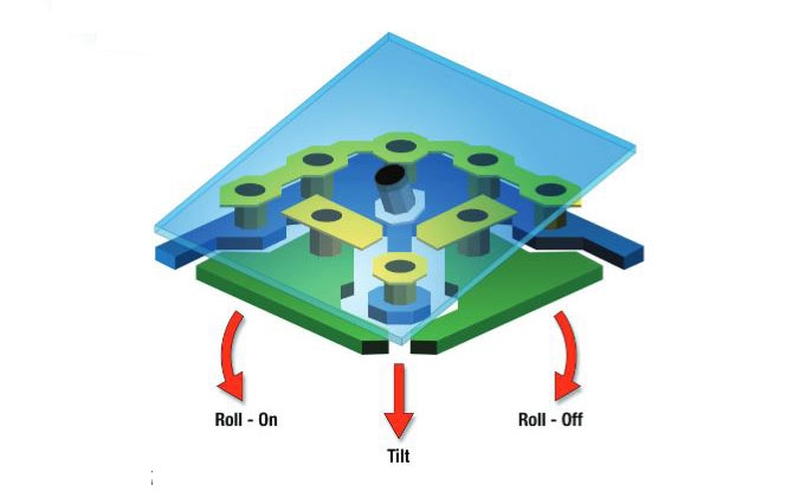
3-Chip vs 1-Chip DLP
As in all LCD and LCoS projectors, some DLP projectors use three DMDs, one each for red, green, and blue. However, these so-called 3-chip models are very expensive. Fortunately for consumers, there's a less-expensive alternative that uses only one DMD.
How can a projector use only one imager? Each primary color—red, green, and blue—is directed to the DMD sequentially, one after the other. The DMD forms the image for each color as that color hits it and reflects the light onto the screen. This happens so fast that the single-color images blend together in our brain to form a full-color image.
To sequence the colors in most single-chip DLP projectors, white light from a lamp passes through a spinning color-filter wheel with filters of different colors in segments around the wheel (Fig. 14). As each segment rotates into the light beam, it allows only its color to pass through and on to the DMD, which forms the image for that color. Then, the next filter segment rotates into position, and the DMD forms the image for that color, and so on.
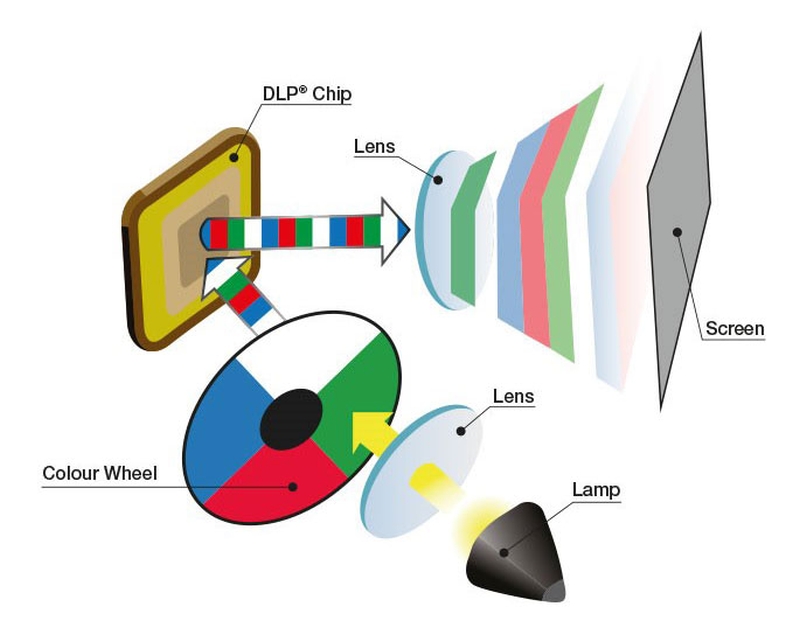
Some color-filter wheels have only red, green, and blue segments—often two sets of RGB, which is referred to as RGBRGB—while others add yellow, cyan, and/or magenta segments to boost those colors (Fig. 15). Some also include a clear segment that lets the white light through while the DMD forms a black-and-white version of the image. This increases the overall brightness of the image, but it also causes a discrepancy between the white and color brightness, which I'll explain in the next section.
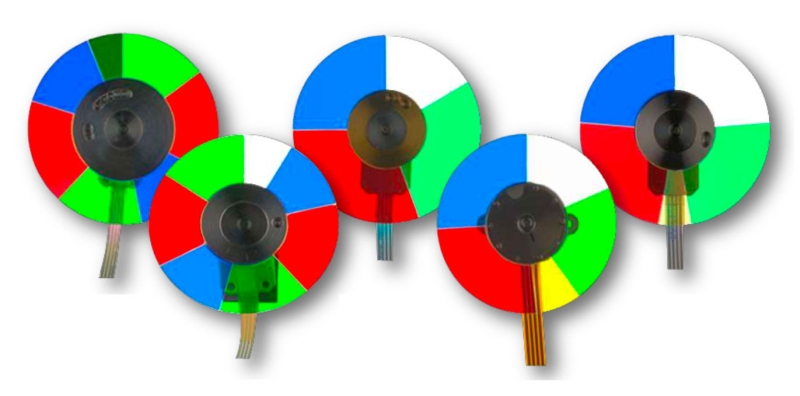
The inclusion of yellow, cyan, and/or magenta color filters in the color wheel is often associated with a Texas Instruments technology called BrilliantColor. The DSP (digital signal processing) used with this technology can also be applied to RGBRGB color wheels. When a boundary between colors rotates into the white light beam, both colors hit the DMD, and the DSP interprets the color combination as a mixture of the two. At the boundary between red and green, the combination yields yellow; the boundary between red and blue yields magenta, while the boundary between blue and green yields cyan. In each case, BrilliantColor boosts the saturation of the secondary colors and increases the optical efficiency of the entire light engine.
Aside from a potential discrepancy between white and color brightness, which I'll explain shortly, there is one other drawback to 1-chip DLP projectors: the rainbow effect. Under certain conditions, many people see fleeting, momentary rainbows on the screen, especially near bright objects on a dark background. Some people are more sensitive to the rainbow effect than others, but for most viewers, once you've seen it, you will continue to see it, at least occasionally. Along with their own sensitivity, the frequency and intensity with which viewers see rainbows varies based on the projector's engineering; a good design minimizes rainbows to whatever extent possible, but different projectors typically produce more or fewer rainbows.
DMD imagers are manufactured exclusively by Texas Instruments, but there are more manufacturers of consumer and commercial 1-chip and 3-chip DLP projectors than the other technologies. Consumer models are offered by BenQ, Digital Projection, JVC, LG, Optoma, SIM2, ViewSonic, Vivitek, and Wolf—among others—and many of those companies also offer DLP projectors for business and other applications. Commercial and digital-cinema DLP projectors are available from Barco, Christie, NEC, Panasonic, and others.
Comparing Projection Tech: LCD, LCoS, and DLP
As you might expect, each technology offers its own strengths and weaknesses. Let's start with the concept of white and color brightness, which I alluded to earlier with respect to 1-chip DLP.
White vs Color Brightness
These terms are easy to define. White brightness (aka white light output or WLO) is the maximum brightness of a full white field—that is, an image that fills the entire screen with solid white. This is how a projector's light output is measured for its published brightness specs.
By comparison, color brightness (aka color light output or CLO) is calculated by adding the maximum brightness of red, green, and blue. Ideally, white and color brightness should be identical, and for all 3-chip projectors—LCD, LCoS, and 3-chip DLP—they are, since white is simply a combination of red, green, and blue. A standard method for measuring color brightness was introduced by SID (Society for Information Display) in 2012.
In addition, white and color brightness are generally identical for 1-chip DLP projectors with RGBRGB color wheels (though the use of BrilliantColor processing might cause a slight discrepancy). When the color wheel includes other filter colors—especially a clear segment—the white brightness will be greater than the color brightness, which is calculated only from the red, green, and blue colors, leaving the extra colors and white out of the equation. The difference between white and color brightness can be as much as a factor of two or three in 1-chip DLP projectors.
Why is this important? If a projector's color brightness is much less than its white brightness, images with saturated colors can appear noticeably dimmer and duller than they would from a projector with equal white and color brightness. You might think this means it is always preferable to have a 3-chip projector that delivers equal white and color brightness, and since all LCD and LCoS projectors are 3-chip designs, you should automatically select one of those. However, depending on the projector, its brightness rating, and the content, ProjectorCentral's tests suggest there can be trade-offs in perceived contrast or color accuracy that may come into play with 3-chip LCD projectors. ProjectorCentral's investigation "ANSI Lumens vs Color Light Output: The Debate between LCD and DLP" takes a close look at this subject. There are also many other factors to consider when selecting a projector, such as the quality of signal processing and optics, and the overall cost just to name a few.
Blacks & Contrast
LCoS is generally considered to have the best inherent blacks and contrast among today's projection display technologies. In fact, for most of their history, JVC did not even include a dynamic iris in its LCoS projectors because it wasn't needed to produce exceptional performance in these areas. More recent models have incorporated a dynamic iris to improve these characteristics even further.
LCD can exhibit excellent blacks and contrast with enhancement techniques such as a dynamic iris and/or dynamic lamp or laser modulation. In particular, Epson's UB (Ultra Black) technology is effective at improving the level of deep black and boosting contrast by using polarized filters to reduce the amount of stray light inside the light engine that would otherwise make its way to the screen.
By comparison, many of the 1-chip DLP projectors I've reviewed over the years have had black levels and contrast that lagged well behind the best LCoS and LCD projectors. Of course, this doesn't mean that DLP projectors always have worse or poor contrast. A projector's overall brightness rating also has an effect on contrast (brighter projectors typically have higher black levels), and as with LCD and LCoS, enhancements like a dynamic iris and/or dynamic light modulation can help a lot. Still, ProjectorCentral's comparison reviews, which directly face-off similar, calibrated home-theater projectors in the same environment, often report better contrast in dark images with LCD and LCoS models compared to single-chip DLP projectors.
Resolution
Author's Note: For this discussion, I make a distinction between "native" resolution, which refers to the number of pixels on the imager, and "true" UHD or 4K resolution, which refers to the number of pixels delivered to the screen in the course of a single frame of video after pixel-shifting.Along with inherently better contrast, another advantage of LCoS among the three technologies is the availability and relative affordability of native-4K resolution. JVC and Sony both offer LCoS projectors with native 4K (4096x2160) resolution for as little as $5,000 to $6,000. DLP with native-4K resolution is available only in digital-cinema and other super-high-end projectors, which run well into six figures, and LCD projectors are not available with native 4K or UHD resolution at all as of this writing (except for the one large-venue model from Epson mentioned earlier).
DLP does offer true UHD (3840x2160) resolution in more affordable consumer projectors using TRP and XPR pixel shifting. Digital Projection even offers true 8K UHD (7680x4320) using quad-shifted XPR with native 4K DMDs.
Some Epson LCD and JVC LCoS models offer two-phase pixel shifting with native 1080p (1920x1080) imagers, which puts 4.15 million pixels on the screen. This is not true UHD, which would require 8.3 million pixels to be delivered to the screen for each frame. However, many respected reviewers have reported that the image from these projectors is subjectively sharper than true 1080p, and that the difference between double-pixel-shifted 1080p and true UHD is minimal. Of course, here again, other factors, including the quality of the image processing and the lens optics, also come into play in these comparisons.
Alignment
One drawback of all 3-chip architectures is the potential for misalignment. If the three images presented by the chips are not perfectly aligned on the screen, you can see color fringing at the edges of objects and other sharp boundaries, and at worst, the image might look soft.
Many LCD, LCoS, and 3-chip DLP projectors offer a pixel-alignment function that lets users shift the red, green, and/or blue pixels by tiny amounts to correct an imperfect factory alignment. In some cases, you can even shift different zones within the image by different amounts.
This is one area where 1-chip DLP has a distinct advantage. The images for all three primary colors—and sometimes other colors, depending on the color-filter wheel—are generated by the same imager, so they are all perfectly aligned.
Cost
Whether you're shopping for a budget model for a dedicated home theater or an expensive state-of-the-art projector for a large-venue installation, cost is almost always a factor. The most expensive projectors today tend to be ultra-high-brightness LCD or 3-chip DLP, while LCD and 1-chip DLP tend to be the least-expensive options among digital projectors, with prices today starting as low as $250. However, the resolution of these models is typically less than 1080p, or they feature low-light LED engines, making them unsuitable for serious home theater.
Today, decent 1080p home-theater projectors typically start around $450 and go up from there. If you search by resolution and price in ProjectorCentral's Find a Projector Database (which lists more than 11,000 current and past projectors), home-theater projectors in the $450 to $1,000 range are almost entirely dominated by 1-chip DLP models from several major brands, including BenQ, Optoma, ViewSonic, Acer, Vivitek, and others. Epson—the only major brand selling LCD projectors for home theater, is represented by a trio of Home Cinema series models in this price range starting at $649.
The lowest-cost UHD models are found in the $1,000 to $2,000 range and include both 1-chip DLP projectors with full UHD resolution (achieved with pixel-shifting) and 3-chip LCD projectors (the latter only from Epson) that have native 1080p imagers but are UHD-compliant and apply pixel-shifting to enhance apparent resolution. Here again, the vast majority are single-chip DLP models. Of course, there are much more expensive—and higher performance—1-chip DLP projectors in the marketplace that utilize the same pixel-shifting XPR technology found in the budget DLP models, though brighter projectors often feature the larger 0.66-inch DMD with native 2716x1528 resolution, which uses only two-phase TRP pixel-shifting instead of the four-phase XPR quadrupling required for the 0.47-inch, native-1080p DMD.
LCoS is generally more expensive than consumer-oriented LCD and 1-chip DLP, and as noted earlier, the home-theater market for this technology is dominated by just two manufacturers, JVC and Sony. The lowest-cost LCoS projector in the ProjectorCentral database is a Sony model with 1080p resolution that costs $1,999. JVC's current LCoS models start with the $3,999 DLA-X790/RS540 model mentioned earlier (until it is phased out), which uses a 1080p imager with e-Shift dual pixel-shifting. Beyond these are native-4K models from both manufacturers, starting at $4,999 for Sony and $5,999 for JVC. Wolf Cinema also offers its own LCoS projectors based on JVC chassis, including native 4K models, starting at $15,000.
The most costly digital projectors are based on 3-chip DLP designs, with most being high-brightness models intended for digital cinema or other color-critical entertainment applications. A few specialty manufacturers tend to dominate this space, among them Barco, Christie, Digital Projection, NEC, and Panasonic. These projectors currently start around $30,000 for 1080p or WUXGA (1920x1200) resolution and a brightness rating of 10,000 lumens, and they range up to native 4K models—or even 8K resolution with pixel-shifting—with brightness as high as 75,000 lumens.
Closing Thoughts
Projectors have come a long way since their hand-cranked beginnings. Today's digital-video projectors render spectacular moving images with greater resolution, higher brightness, more contrast, and a wider range of colors than ever before. Even better, most of those gains are available at lower cost to more consumers, businesses, schools, museums, and houses of worship, bringing more impact to a wider audience. Of course, the highest possible quality remains very expensive, but it's amazing how well even the least-expensive modern projectors perform.
Now that you have a better understanding of exactly how digital-video projectors work—and the strengths and weaknesses of each technology—you can shop with confidence for one that precisely suits your needs and budget. Then, sit back, relax, and dig into an endless visual feast.
The author wishes to offer profound thanks to 3LCD, BenQ, Digital Projection, Epson, and JVC for their help with this article.
LCD, LCoS, DLP Comparison Summary
LCD
Pros
- No difference between white and color brightness
- No rainbow artifacts
- Potential for excellent blacks and contrast with enhancement technology
- Relatively inexpensive
Cons
- Possible panel alignment issues
- Dual-pixel-shifted 1080p, not true UHD
Primary Applications
- Home Theater
- Education: K-12
- Education: Higher Ed
- Corporate
- House of Worship
- Sports Bar
- Museum
- Large Venue (Rental/Staging, Theme Park)
Primary Manufacturers
- Christie
- Epson
- Maxell
- NEC
- Panasonic
- Ricoh
- Sony
LCoS
Pros
- Native 4K in many cases, no pixel shifting
- Generally excellent blacks, shadow detail, contrast
- No difference between white and color brightness
- No rainbow artifacts
Cons
- Possible panel alignment issues
- Usually more expensive than 1-chip DLP and LCD
- Less-expensive models are dual-pixel-shifted 1080p, not true UHD
Primary Applications
- Home Theater
- Corporate
- Digital Cinema
- Simulation
Primary Manufacturers
- Canon
- JVC
- Sony
- Wolf
3-Chip DLP
Pros
- Native 4K in most-expensive cases, no pixel shifting
- True UHD with TRP or XPS pixel shifting
- No difference between white and color brightness
- No rainbow artifacts
Cons
- Possible panel alignment issues
- Very Expensive
Primary Applications
- High-End Home Theater
- Large Venue (Rental/Staging, Theme Park)
- Digital Cinema
- Museum
- Simulation
Primary Manufacturers
- Barco
- Christie
- Digital Projection
- NEC
- Panasonic
- SIM2
1-Chip DLP
Pros
- True UHD with TRP or XPS pixel shifting
- No alignment issues
- Most cost-effective option in most brightness and resolution classes
Cons
- Possible difference between white and color brightness
- Rainbow artifacts
- Sometimes higher black levels, lower contrast
Primary Applications
- Home Theater
- Education: K-12
- Education: Higher Ed
- Corporate
- House of Worship
- Sports Bar
- Museum
- Large Venue (Rental/Staging, Theme Park)
Primary Manufacturers
- BenQ
- Digital Projection
- JVC
- LG
- Optoma
- SIM2
- Panasonic
- ViewSonic
- Vivitek
- Wolf
Although, I never understood why a 3-chip DLP projector has to be so expensive.
Really there is no rea,son (technical or economical) why there is no 3-chip DLP projector priced under $5000 yet.
Its like combining 3 (RGB) $1000 DLP projectors, add another $1000 for the lens, plus $1000 for alignment/production costs.
The rainbow artifacts throw me off. Its not just the artifacts, but the eye fatigue, I cannot watch too long at the screen. I am glad a movie ends.
Thats why I am hoping you can review the upcomming LG ProBeam Laser 4K (5.000 ANSI lumen) I read it has no color wheel.
Sounds promising!
We are reviewing the LG ProBeam right now, but this is very much a commercial projector for ambient light environments and given the brightness is not likey to provide particularly good black levels or contrast. Still, it is UHD resolution, and we'll be taking a look at how it might fare for ambient-light theater viewing.
One piece of advice, for me the rainbow effect is the worst on white and yellow parts in the image. Trying not to focus to much on these image parts helped me with adapting to using a DLP projector as my main projector.
As hans priece mentioned; the Appotronics camp is also stepping into this price segment.
I’m looking forward to your review of the LG ProBeam Laser 4K projector and if it compares to the Viewsonic LS700-4k.
@Chris4711DE Interesting observation. I’ll look into this LED and Laser frequency comparison at my local dealer. Thanks for the tip. Maybe the Phosphor wheel implementation is to blame for the rainbows in this laser technology.




